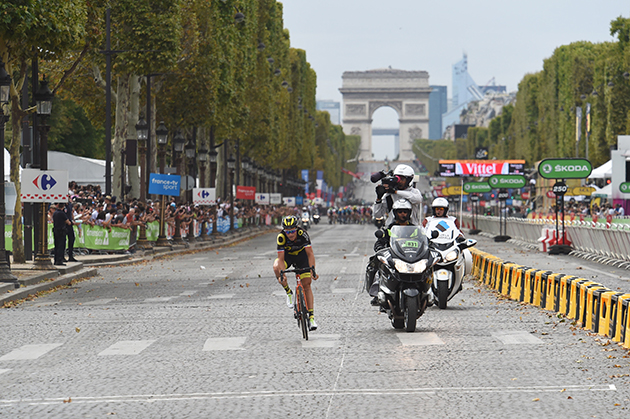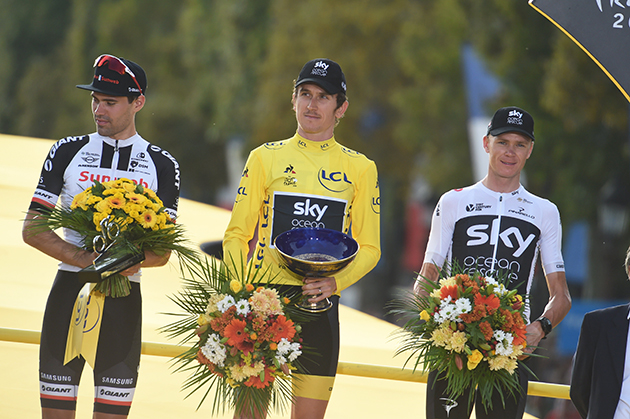

David L. Stanley
Sixteen Random Thoughts as We Say Good-bye to
Tour de France 2018

David Stanley is an experienced cycling writer. His work has appeared in Velo, Velo-news.com, Road, Peloton, and the late, lamented Bicycle Guide (my favorite all-time cycling magazine). He blogs regularly for Dads Roundtable. Here's his Facebook page. He is also a highly regarded voice artist with many audiobooks to his credit, including McGann Publishing's The Olympics' 50 Craziest Stories and Cycling Heroes.
And there is his masterful telling of his bout with skin cancer, "Melanoma: It Started With a Freckle". It's available as an audiobook narrated by the author here. For the print and Kindle eBook versions, just click on the Amazon link on the right.

David L. Stanley
David Stanley writes:
Sylvain Chavanel (Direct Energie). The 39-year-old Chava has had an incredible career. He’s won big races. He’s been a national champion many times over. He’s worn the Maillot Jaune. He’s a real bike racer, always willing to get in the breakaway and do the work. According to Jens “Shut up Legs” Voigt, when Jensie looked over and saw Sylvain in a group with him, Jens said he knew the break was on.
This year, Sylvain raced in his 18th Tour de France. How much racing is that? Sylvain has logged over 365 days racing the Tour. That’s right, he has spent over one full year with a pair of Tour de France numbers pinned to the back of his jersey. Chava’s dream job upon retirement? Driving a moto for the Tour.

Tour de France stage 21: Sylvain Chavanel was allowed to be the first rider on the Champs Elysées and rode a solo lap of honor. Sirotti photo

Lawson Craddock. The Houston-born Education First-Drapac racer is one tough hombre. A Stage 1 crash shredded his face and broke his scapula. “No worries,” said Awesome Lawson, ”just tape me up and I’ll keep on marching.” Ever break a scapula? Move your arm forward, backward, brush your teeth, hang on to a handlebar at 45 kph over the Paris-Roubaix cobblestones – those efforts pull, at every moment, at your scapula. If you don’t know what it feels like to have the segments of broken bones grate against each other, just imagine taking a big bite out an apple minutes after a root canal. Yeah, like that.
The real kicker? Awesome Lawson grew up racing on Houston’s Allkek velodrome which was badly damaged during Hurricane Harvey. So, what did Lawson do? For every day he made the time limit of the stage, he’d kick in money to a fundraiser for the velodrome and challenged people to do the same. End result-as of stage 20, Lawson’s fund has generated over $161K for renovations. He’s the Lanterne Rouge, last place, but take a look at all the fine riders that never saw Paris. He finished way ahead of all those guys.
Broken Riders. By my rough count, 8 riders soldiered on with broken bones to finish a stage. Several of them managed to get to Paris. Four that stick with me, in no particular order:
Vincenzo Nibali (Bahrain) – broke a vertebral body of T10 on Alpe d’Huez and managed to finish the stage. He underwent a procedure to inject the break, through the skin, a bone cement that acts to hold the broken parts together.
Taylor Phinney (Education First-Drapac) – smashed his nose into a tree on the descent. Spent most the last stage in Paris off the front in a small breakaway.
Philippe Gilbert (Quick Step) – flew into the forest, shattered his patella, raced another 50 km to the finish, and only then, off to hospital for surgery.
Rigoberto Uran (Education First-Drapac) – crashed badly on the cobblestone stage, rode three more stages before his injuries wore him down and he was forced to retire.
You probably have your own favorite injured rider story. Why not leave it in the comments on the Bike Race Info/McGann Publishing FB page?
The Sprinters’ Thunderdome. Twenty-two sprinters enter. 7 sprinters (more or less) left to battle it out. This year’s parcours (more on that later) was particularly brutal for the sprinters. Historically, many sprinters (Cipollini, cough, cough) would bail before Paris. But there’s a difference between sprinters who quit, and sprinters who just couldn’t get over the mountains within the time cut. Cav? Gone. Greipel? Gone. Gaviria? Gone. Groenewegen. Gone. Who made it to Paris with speed in their legs? Boassen-Hagen. Colbrelli. Kristoff. Degenkolb. Demare. LaPorte. Sagan.
Peter Sagan. The Bora-Hansgrohe leader struck gold. Not only did he grab three stage wins, he wrapped up the Green Jersey 5 stages before the end of the race. 270 points ahead of second place Alexander Kristoff, this was Sagan’s 6th maillot vert. That ties him with Erik Zabel (1996-2003 drugs list: EPO and cortisone) who confessed that he used drugs to win his 6 green jerseys in a row. How big an asterisk does Zabel have next to his name? Really big.

Green Jersey number six for Peter Sagan. Sirotti photo
John Degenkolb. In January, 2016, Degenkolb and 5 teammates were hit head-on whilst they trained in the south of Spain. He suffered the near-loss of a finger, broken bones, and plenty of deep cuts. Talk to anyone hit by a car whilst on a bike. It is a life-changing moment in time. Since the accident, it was clear that John lost at least his swash in the sprints, and maybe his buckle as well. His victory on the cobbles of Stage 9 in a sprint over Greg van Avermaet (BMC) was as much life-affirming as it was victorious.
The Race Route. Golf’s British Open declares its victor “The Champion Golfer of the Year.” Since they’ve been handing out the Claret Jug for 158 years, that seems fair. The Tour de France could easily make the same case. For 115 years, the Grand Boucle has been testing riders, teams, and machines. It’s only right that the route should encompass all the challenges a rider might face within the season within the span of 21 days in July. Cobbles. Climbs to the tops of the Alps and Pyrenees. Sprints. The time trial. The long days in the saddle. The short, mad dashes.
This year’s parcours was spot-on. The 65-km stage 17 to St. Lary-Soulan, complete with F1 starting grid was a dare that worked. The 31-km hilly time trial of stage 20 had every fan on the edge of a seat. Truly, the route was genius this year – only the best remained standing (no pun intended, as we lost too many great riders) for the ride down the Champs-Elysees.
A Brutal Race. How many teams finished intact; a full complement of 8 riders? That would be six. Only six teams managed to keep everyone upright and healthy throughout the race. The heat, the merciless climbing, the daily wear and tear of crowded roads, accumulated fatigue, and crashes; they all told their stories. One of the six was Wanty Group-Gobert, a second division team that earned a special invitation by ASO. ASO looked good on this; not only were Wanty Group active in nearly every day’s breakaway attempts, they managed to get a rider, Guillame Martin, into the battle for the Maillot Blanc, the best rider under 25 competition. Martin took third place.
How strong a tell is the White Jersey competition? In 2013, the white jersey results were:
-
1. Nairo Quintana
2. Andrew Talansky
3. Michal Kwiatkowski
4. Romain Bardet
5. Tom Dumoulin
You’d probably like to have those guys on your fantasy cycling team, eh?
Pepper Spray and Smoke Flares. Angry people who use the Tour for their own ends have always been with us. Bernard Hinault showed his worth as a middleweight boxer when he cold-cocked several protesters who dared to interrupt the Tour. Eddy Merckx, in 1975, was punched in the gut by an unhappy 55-year-old man named Nello Breton.
Unfortunately, many of our worst fears about crowds and terror and sports have come true. Munich. Boston. That’s enough. That’s why I was pleased to see the gendarmerie take after the protestors who charged stage 16. Unfortunate as all Hell for the riders who were caught up in the spray as it drifted back, but still, a good sign to all that during the Tour, cops are everywhere.
The flares. Holy crap, what a bunch of blithering asshats. Smoke flares belong on the roadside when a car breaks down. Not at a bike race. I can’t stand them on the pitch, either. It’s impossible to breathe, and hey, you idjits, breathing is pretty important to athletes.
The Coverage and the Tech. I loved watching the Tour in 2018. It’s easy for me to recall crowding around a TV in a Milwaukee college dorm during Superweek in 1985 to watch the early coverage of the Tour. 30 hours of the week’s racing edited down to 90 minutes of well-produced sports entertainment. It’s my youth, and yes, I still get goosebumps when I hear the John Tesh soundtrack.
But this? Oh, my. Cameras on board the racers’ bikes. Cameras on-board the motos. Aerial shots from any one of half-a-dozen helicopters overhead. Live telemetry with riders’ power outputs and speed and heart rates, GPS that tells us exactly how far ahead the breakaways are. A special S-O to Christian vande Velde. His recon rides with the Google glass and microphone and his biometric data were an incredible inside look at the routes from the saddle of a guy who has won a race or two.
The whole production is off-the-charts. As Bob Roll said on the last day, “It’s Woodstock on wheels for a month.” 65 people from 10 nations on the road with 12 semi-trucks to haul the gear, set it up, and 20 hours later, break it down, load it out, and head 200 kilometers across twisting, Alpine roads to set it up again. [Cue Jackson Browne singing The Load-out/Stay on his Running on Empty LP.]
Steve Porino. I’m a huge fan. Part of my fan-dom is that for most of his 20s, Steve P. was a member of the US National Alpine team. He was a downhiller, never comfortable on skis unless he was going at least 45 mph. He raced the Hahnenkahm, the most dangerous day in ski racing. So there’s that.
But what Steve does is well-beyond that. He gets inside the team cars. He gets directors and mechanics and soigneurs to tell him things that enhance our appreciation for the race. He holds interviews rolling down the road from the back of his moto. He’s cycling’s Man on the Scene for 21 days. (I am both jealous and full of admiration for his gig) Which brings me to…
Patrice Diallo. He drives Porino’s moto. Does it every year. Google him, he looks like a guy who should drive a BMW R1200RT down an Alpine descent at 80 mph. Patrice got his start driving for the finest cycling photog of our day, Graham Watson. Patrice was Graham’s driver in Paris-Nice, 1984; a race won by the Irishman Sean Kelly. Which leads me to…
Dan Martin. No, Dan Martin is not Irish. He’s from Birmingham, the son of a fine British pro, Neil Martin. Neil married Maria Roche, the sister of one of the all-time greats, Irishman Stephen Roche. As in horse racing, bloodlines matter. Dan (UAE-Team Emirates) has had a stellar pro career, a winner of classics, Monuments, and week-long stage races. But this year, he won an award that is oft-ignored but deserves respect - The Combativity Prize.
In cycling, it is the attack that matters. The guy who attacks, attacks, attacks is always held in the highest esteem by his peers. It’s considered better to attack, be away for 80 km, get reeled in with 1.2 km to go and finish just behind the bunch in exhaustion than it is to do little except take 18th in the field sprint.
To paraphrase the noted poet and athletic critic, Vanilla-Ice: “If there’s an attack Dan Martin’s in it, watch him suffer while he try to win it.” BTW- the lumpy Stage 6 to Mur-de-Bretagne with a finishing wall reminiscent of an Ardennes Classic? Dan Martin took the win. Chapeau, Dan Martin.

Dan Martin riding the stage twenty time trial. Sirotti photo
Egan Bernal. Every so often in sport, you see greatness unveiled. Michael Jordan’s first game he went for 16 points, 7 assists, 6 rebounds. Tiger Woods turned pro in August, 1996, and won The Masters the following April. This year, at the Tour, we saw the future of cycling and it looks a lot like Egan Bernal. The 21-year-old Team SKY racer can climb with anyone in the peloton. He is a tolerable time trialist (Colombian National Champion) and that is a skill that improves with age and coaching.
Most tellingly, he signed a 5-year contract with SKY during the Tour. Love Sky or not, their track record of finding and retaining talent is mind-boggling. Favorite moment - Stage 19 in the Pyrenees. His job was to pace an obviously struggling Chris Froome through the mountains. Bernal accelerated to follow a move and gapped Froome by about 5 bike lengths in 10 seconds time. He must have had team DS Nicolas Portal screaming in his ear because he sat up straight on his bike like someone in a Grade B Horror flick who is terror-stricken in bed.
Geraint & Froomey. In Australia, they call it mateship. You look out for your mates - you die to kick each other’s ass on the field of play, no whining about the calls, no gloating about a win, and afterwards, you put it all aside and have a beer together. Perhaps the best example is rugby. Men and women smack each other into next week for 80 minutes and then queue up at the keg to guzzle some Foster’s and talk about the game. The next best example of mateship might be Geraint and Froomey from this year’s Tour de France.
Let’s go back a few years. The 2012 Tour de France, Stage 17. Froomey is riding in support of Brave Brave Sir Wiggo in the Pyrenees. BBSW was dying on Froomey’s wheel. As Froome coasted and waited for his captain, between his hand gestures and the “I smell shit” look on his face, Froome’s opinion was on display for all to see. Here, see for yourself.
Let’s go back a few more years. The 1985 Tour de France. Greg LeMond is floating as he climbs. Bernard Hinault, the leader, is in the yellow jersey, but on a bad day as they climb to Luz-Ardiden. Stephen Roche is on a very good day, and he attacks. LeMond, the good teammate, covers the attack. But he is ordered to sit on, not to share in the attack. Together, they would have dropped Hinault hard, putting the yellow jersey at risk, and perhaps on the shoulders of Roche. After the stage, LeMond is stating his case with his team’s director, Paul Koechli. Forcefully. A passerby decides to intervene with words of support for Greg. Greg responds, “You wanna get punched in the face?” And judging from the interactions between Greg and Bernie going forward, Greg may as well have shouted those words at Hinault himself. Here, see for yourself. Skip to around 5:30.
We saw none of this between G and Froome. Every word that Froome said in praise of G rang true. Whether speaking of Geraint during the late stages, or in the interviews after the race, Froome was sincere, open, and laudatory. For his part, Thomas was equally fair, praising Froome for his support, for the lessons Thomas learned from him, and how much he appreciated Froome’s respect.
Perhaps it was the wisdom of the ages. LeMond was 24, Hinault 31, during the siege of Luz-Ardiden in 1985. Froome was 27, Wiggo 32 during that gloomy day in 2012. Today, Froome is 33 and Geraint Thomas is 32.
Perhaps it is that Hinault is a difficult man under the best of circumstances. Brad Wiggins has been described as a bit of a testy bloke as well. Maybe it’s that Geraint and Froome are genuinely nice guys who also appreciate each other’s talent.
Whatever it is, it’s good to see and sport would benefit from seeing more of it.

The tour's final podium, from left: Tom Dumoulin, Geraint Thomas & Chris Froome. Sirotti photo.
Congratulations, Geraint; a valiant warrior and King of Arthurian legend, aptly named. Thank-you for a great ride, for great sport, for great mateship.
With the end of the Tour, I have a dilemma. The World Cup is over. The British Open is over. Wimbledon is over. The Tour de France is over. What am I going to do with myself? I think I’ll go for a bike ride and think this over. You should do the same.
Vive Le France! Vive Le Tour!
- Visit the McGann Publishing Facebook page
- On the Twitter, you can follow BikeRaceInfo here.
- Stanley’s Twitter is here. I tweet early, and often.







